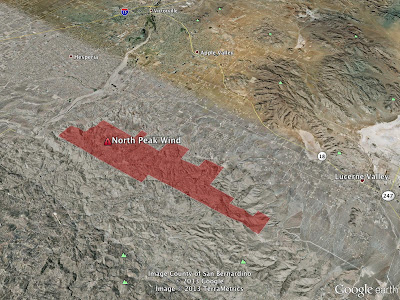Wind Developer Targets Victor Valley's Juniper Flats

Chicago-based energy company E ON Climate and Renewables is planning to install 42 wind turbines, each over 400 feet tall, on the Juniper Flats area of Victor Valley. The company has been testing wind resources in the area since 2010, and submitted notice to the Bureau of Land Management in January of its intent to begin the environmental review process to build the industrial-scale project. The current right-of-way application spans over 23 square miles of public lands at the foot of the San Bernardino National Forest. [Click on image to expand] An approximate outline of the North Peak Wind project proposed right-of-way on public lands in the Juniper Flats area, located in the southeastern Victor Valley. Juniper Flats are a prized recreation area for residents of the Victor Valley, where many enjoy hiking, mountain biking, horseback riding, hang-gliding, and 4x4 driving on designated routes. The area features riparian habitat that attracts a range of wildlife, including great



